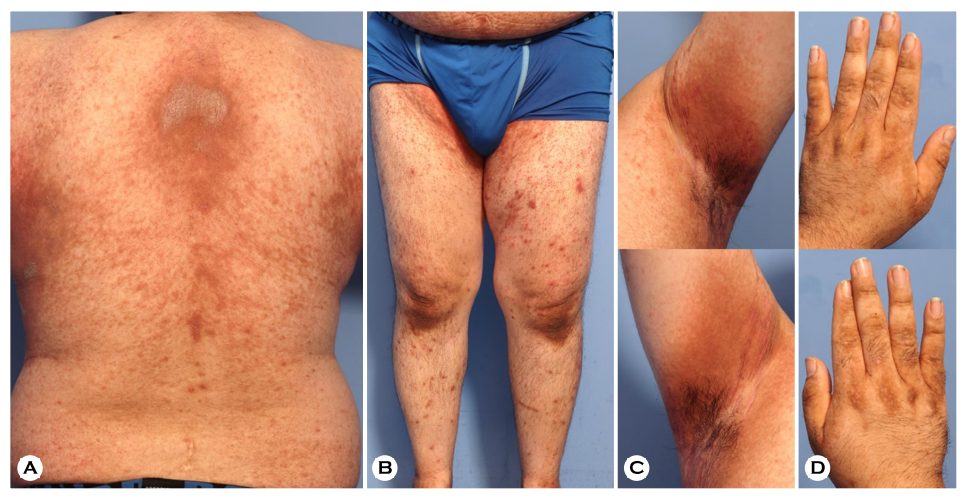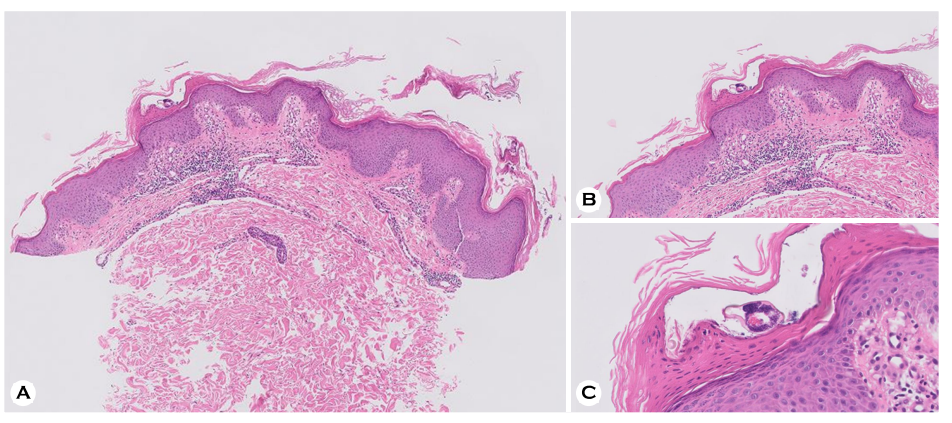pISSN : 3058-423X eISSN: 3058-4302
Open Access, Peer-reviewed

pISSN : 3058-423X eISSN: 3058-4302
Open Access, Peer-reviewed
Eun Hee Yoo,Seung Ah Yoo,Marianne Isabel A. Sayo,Ji Hyun Lee
10.17966/JMI.2022.27.3.57 Epub 2022 October 05
Abstract
PATIENT CONSENT STATEMENT
The patient provided written informed consent for the publication and the use of his images.
Keywords
Darier's disease, also known as dyskeratosis follicularis or keratosis follicularis, is an autosomal dominant inherited skin disorder characterized by yellowish to brownish, greasy papules and plaques in the first or second decade of life. The skin lesions predominantly erupt on the seborrheic areas, including the scalp, forehead, trunk, and groin1.
Scabies is a parasitic infestation of the skin caused by the mite Sarcoptes scabiei, which presents with multiple mor- phologies. The typical distribution of scabies infestation is mainly the interdigital spaces of the fingers; however, it can be also observed in the wrists, axillae, groins, buttocks, and genitals. Because the diagnosis of scabies is made largely on clinical grounds, atypical scabies is often misdiagnosed as other skin diseases2. Here, we report a rare case of scabies resembling Darier's disease.
A 39-year-old man with a medical history of hypertension and dyslipidemia presented to our clinic with generalized pruritic skin lesions for 1 year. Physical examination revealed erythematous to brownish hyperkeratotic papules and plaques predominantly on the upper back and flexural areas. No burrows on the web spaces or nail involvement were found in this patient (Fig. 1). The patient's parents had similar pruritic skin lesions. The laboratory findings were unremarkable. With the initial suspicion of Darier's disease, the patient was treated with acitretin, corticosteroid, and cyclosporine for 1 year at a local clinic. Although the symptoms slightly improved, the lesions remained; therefore, the patient was referred to our clinic.
Skin punch biopsy was performed, and histopathological examination showed a scabies infestation (Fig. 2) without any pathological evidence of Darier's disease. Based on the patient's history and clinical and histological findings, the patient was finally diagnosed with atypical, crusted scabies. He and his family were treated successfully with permethrin cream and topical corticosteroid.
Scabies is difficult to diagnose even for experienced physicians because of its multiple clinical morphologies. In the patient in this case report, the skin lesions that occurred mainly on the back, axilla, and inguinal areas and not the interdigital web spaces might have led to the suspicion of Darier's disease rather than scabies infestation.
The hyperkeratotic, crusted papules and plaques are an uncommon clinical presentation of scabies infestation, which made it difficult to diagnose. Crusted scabies, also referred to as Norwegian scabies, presents as hyperkeratotic papules or plaques that should be distinguished from other skin diseases, such as psoriasis, seborrheic dermatosis, and Darier's disease3. It is often associated with immunocompromised states caused by topical glucocorticoids4,5. It is hypothesized that the reduced inflammatory response elicited by sensitization to scabies infestation in immunosuppressed hosts promotes the atypical clinical manifestations of scabies3. In the patient in this case report, it can be presumed that he was immuno- suppressed due to the long-term use of cyclosporine and extensive topical corticosteroids, which may reduce local immune responses and promote the atypical features of scabies infestation.
In conclusion, we report an atypical case of scabies resem- bling Darier's disease in Korea. This case report highlights that the clinical presentation of Darier's disease could be unusual types of scabies, although rare. If Darier's disease does not improve with proper treatment, it should be distinguished clinically and histologically from scabies.


References
1. Sehgal VN, Srivastava G. Darier's (Darier–White) disease/ keratosis follicularis. Int J Dermatol 2005;44:184-192
2. Thomas C, Coates SJ, Engelman D, Chosidow O, Chang AY. Ectoparasites: Scabies. J Am Acad Dermatol 2020; 82:533-548
Google Scholar
3. Anolik MA, Rudolph RI. Scabies simulating darier's disease in an immunosuppressed host. Arch Dermatol 1976;112: 73-74
Google Scholar
4. Bilan P, Colin-Gorski AM, Chapelon E, Sigal ML, Mahé E. Crusted scabies induced by topical corticosteroids: A case report. Arch Pediatr 2015;22:1292-1294
Google Scholar
5. Marlière V, Roul S, Labrèze C, Taïeb A. Crusted (Norwegian) scabies induced by use of topical cortico- steroids and treated successfully with ivermectin. J Pediatr 1999;135:122-124
Google Scholar
Congratulatory MessageClick here!